Past Year Questions: Flow Through Pipes | Fluid Mechanics for Civil Engineering - Civil Engineering (CE) PDF Download
Q1: A 2 m × 1.5 m tank of 6 m 6 m height is provided with a 100 mm diameter orifice at the center of its base. The orifice is plugged and the tank is filled up to 5 m height. Consider the average value of discharge coefficient as 0.6 and acceleration due to gravity (g) as 10 m/s2. After unplugging the orifice, the time (in seconds) taken for the water level to drop from 5 m to 3.5 m under free discharge condition is _____ (rounded off to 2 decimal places). [2024, Set-II]
Ans: 102 to 106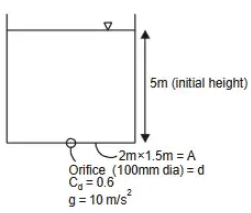
Let at any instant depth of liquid in tank is 'h' m and in time (dt), the depth falls by (-dh)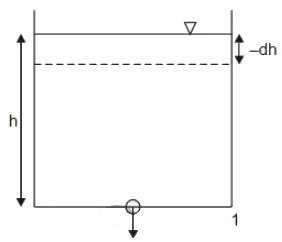
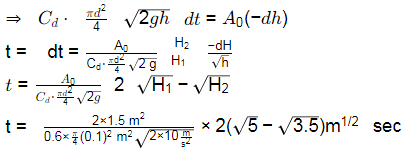
t = 103.985sec
Q2: With respect to fluid flow, match the following in Column X with Column Y: Which one of the following combinations is correct? [2022, Set-I]
Which one of the following combinations is correct? [2022, Set-I]
(a) (P) - (II), (Q) - (IV), (R) - (I), (S) - (III)
(b) (P) - (III), (Q) - (IV), (R) - (I), (S) - (II)
(c) (P) - (IV), (Q) - (II), (R) - (I), (S) - (III)
(d) (P) - (II), (Q) - (IV), (R) - (III), (S) - (I)
Ans: (a)
Reynold's number (Re) is defined when apart from inertial force, viscous forces are dominant.
Froude?s number (Fe): It is used when in addition to inertial force, gravity forces are important.
Mach number (M): It is used when in addition to inertial force, compressibility forces are dominant
Q3: A venturimeter as shown in the figure (not to scale) is connected to measure the flow of water in a vertical pipe of 20 cm diameter.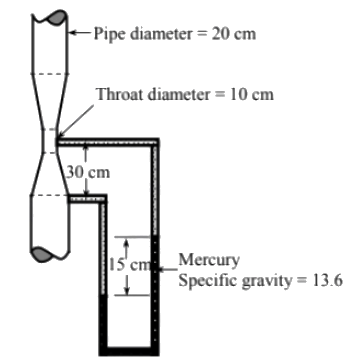 Assume g = 9.8 m/s2. When the deflection in the mercury manometer is 15 cm, the flow rate (in lps, round off to two decimal places) considering no loss in the venturimeter is ___________ [2021, Set-II]
Assume g = 9.8 m/s2. When the deflection in the mercury manometer is 15 cm, the flow rate (in lps, round off to two decimal places) considering no loss in the venturimeter is ___________ [2021, Set-II]
(a) 49.4
(b) 23.36
(c) 87.64
(d) 68.22
Ans: (a)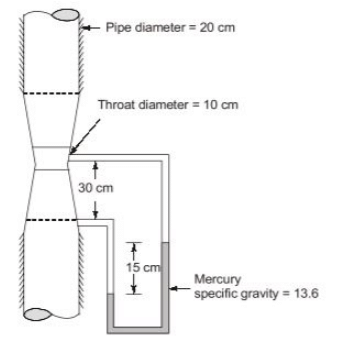

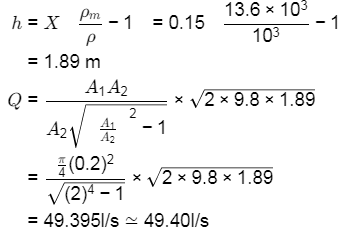
Q4: A fire hose nozzle directs a steady stream of water of velocity 50 m/s at an angle of 45∘ above the horizontal. The stream rises initially but then eventually falls to the ground. Assume water as incompressible and inviscid. Consider the density of air and the air friction as negligible, and assume the acceleration due to gravity as 9.81 m/s2. The maximum height (in m,round off to two decimal places) reached by the stream above the hose nozzle will then be _________ [2021, Set-II]
(a) 63.71
(b) 56.21
(c) 98.36
(d) 88.24
Ans: (a)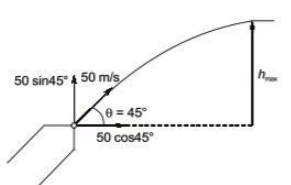
As we know that
V2 - u2 = 2as
In vertical direction ( ↑ )
02 − (50 sin 45∘) 2 = 2 (− 9.81) hmax 
Q5: A fluid flowing steadily in a circular pipe of radius R has a velocity that is everywhere parallel to the axis (centerline) of the pipe. The velocity distribution along the radial direction is  where r is the radial distance as measured from the pipe axis and U is the maximum velocity at r = 0. The average velocity of the fluid in the pipe is [2021, Set-I]
where r is the radial distance as measured from the pipe axis and U is the maximum velocity at r = 0. The average velocity of the fluid in the pipe is [2021, Set-I]
(a) U/2
(b) U/3
(c) U/4
(d) 
Ans: (a)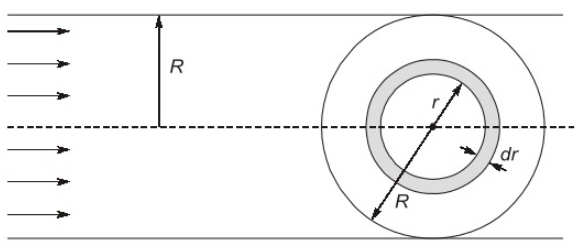



Q6: A cast iron pipe of diameter 600 mm and length 400 m carries water from a tank and discharges freely into air at a point 4.5 m below the water surface in the tank. The friction factor of the pipe is 0.018. Consider acceleration due to gravity as 9.81 m/s2. The velocity of the flow in pipe (in m/s, round off to two decimal places) is __________. [2020, Set-II]
(a) 2.56
(b) 1.52
(c) 4.12
(d) 6.82
Ans: (a)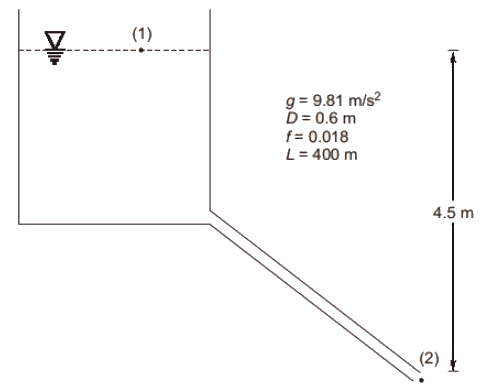 Apply energy equation between (1) and (2)
Apply energy equation between (1) and (2)
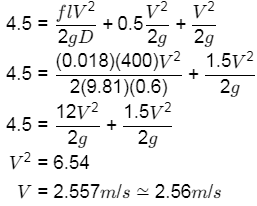
Q7: Two identically sized primary settling tanks receive water for Type-I settling (discrete particles in dilute suspension) under laminar flow conditions. The surface overflow rate (SOR) maintained in the two tanks are 30 m3 /m2 ⋅ d and 15 m3/m2 ⋅ d. The lowest diameters of the particles, which shall be settled out completely under SORs of 30 m3/m2 ⋅ d and 15m3/m2 ⋅ d are designated as d30 and d15 respectively. The ratio d30/d15 (round off to two decimal places), is __________. [2020, Set-II]
(a) 2
(b) 1.41
(c) 0.85
(d) 2.35
Ans: (b)
For type-I setting, Stokes law is applicable.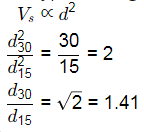
Q8: A circular water tank of 2 m diameter has a circular orifice of diameter 0.1 m at the bottom. Water enters the tank steadily at a flow rate of 20 litre/s and escapes through the orifice. The coefficient of discharge of the orifice is 0.8. Consider the acceleration due to gravity as 9.81 m/s2 and neglect frictional loses. The height of the water level (in m, round off to two decimal places) in the tank at the steady state, is ______. [2020, Set-I]
(a) 0.25
(b) 0.34
(c) 0.52
(d) 0.78
Ans: (c)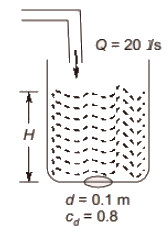 Assume H is the level of weter in the tank in steady condition.
Assume H is the level of weter in the tank in steady condition.
For steady water level in the tank
Discharge through orifice = Water enters in the tank

H = 0.5164
Q9: Three reservoir P, Q and R are interconnected by pipes as shown in the figure (not drawn to the scale). Piezometric head at the junction S of the pipes is 100 m. Assume acceleration due to gravity as 9.81 m/s2 and density of water as 1000kg/m3. The length of the pipe from junction S to the inlet of reservoir R is 180 m. Considering head loss only due to friction (with friction factor of 0.03 for all the pipes), the height of water level in the lowermost reservoir R (in m, round off to one decimal places) with respect to the datum, is ________. [2020, Set-I]
Considering head loss only due to friction (with friction factor of 0.03 for all the pipes), the height of water level in the lowermost reservoir R (in m, round off to one decimal places) with respect to the datum, is ________. [2020, Set-I]
(a) 32.09
(b) 97.51
(c) 121.25
(d) 78.45
Ans: (b)
Apply conutinuity
Q3 = Q − 1 + Q2
= A1V1 + A2V2 
Apply energy eq. between (S) and (R)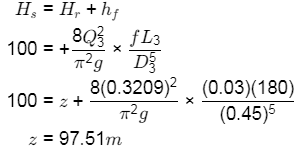
Q10: Two identical pipes (i.e., having the same length, same diameter, and same roughness) are used to withdraw water from a reservoir. In the first case, they are attached in series and discharge freely into the atmosphere. In the second case, they are attached in parallel and also discharge freely into the atmosphere. Neglecting all minor losses, and assuming that the friction factor is same in both the cases, the ratio of the discharge in the parallel arrangement to that in the series arrangement (round off to 2 decimal places) is _______ [2019 : 2 Marks, Set-II]
Ans: Given: Two identical pipes of same length (L), diameter (D) and roughness (ks).
1st case (Series)
Assume height of reservoir = H
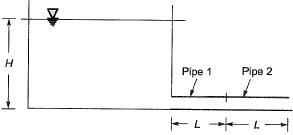
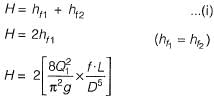
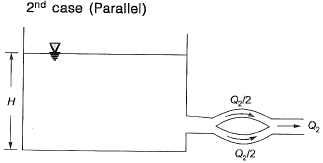

By eq. (i) and (ii)
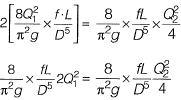
=2.83 (round off to 2 decimal place)
Q11: Two water reservoirs are connected by a siphon (running full) of total length 5000 m and diameter of 0.10 m, as shown below (figure not drawn to scale).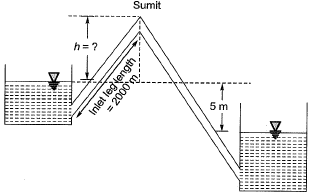 The inlet leg length of the siphon to its summit is 2000 m. The difference in the water surface levels of the two reservoirs is 5 m. Assume the permissible minimum absolute pressure at the summit of siphon to be 2.5 m of water when running full. Given: friction factor, f = 0.02 throughout, atmospheric pressure — 10.3 m of water and acceleration due to gravity g = 9.81 m/s2. Considering only major loss using Darcy-Weisback equation, the maximum height of the summit of siphon from the water level of upper reservoir, h (in m, round off to 1 decimal p lace) is_______. [2019 : 2 Marks, Set-I]
The inlet leg length of the siphon to its summit is 2000 m. The difference in the water surface levels of the two reservoirs is 5 m. Assume the permissible minimum absolute pressure at the summit of siphon to be 2.5 m of water when running full. Given: friction factor, f = 0.02 throughout, atmospheric pressure — 10.3 m of water and acceleration due to gravity g = 9.81 m/s2. Considering only major loss using Darcy-Weisback equation, the maximum height of the summit of siphon from the water level of upper reservoir, h (in m, round off to 1 decimal p lace) is_______. [2019 : 2 Marks, Set-I]
Ans:
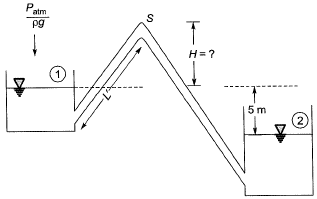
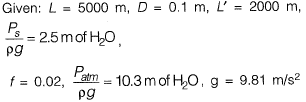
Consider only major losses
Apply energy equation between (1) and (2)
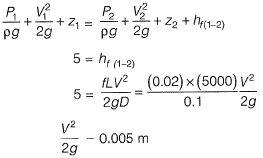
Apply energy equation between (1) and (S)


10.3 = 2.505 + H + 2
H = 5.795
H = 5.8 m (upto 1 decimal place)
Q12: Water is pumped at a steady uniform flow rate of 0.01 m3/s through a horizontal smooth circular pipe of 100 mm diameter. Given that the Reynolds number is 800 and g is 9.81 m/s2, the head loss (in meters, up to one decimal place) per km length due to friction would b e _________. [2017 ; 2 Marks. Set-II]
Ans:

Head loss due to frictions,
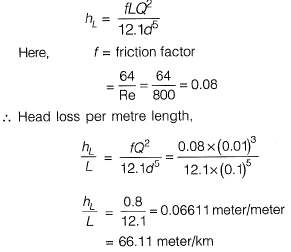
Q13: A triangular pipe network is shown in the figure The head loss in each pipe is given by hf = rQ1.8, with the variables expressed in a consistent set of units. The value of r for the pipe AB is 1 and for the pipe BC is 2. If the discharge supplied at the point A (i.e., 100) is equally divided between the pipes AB and AC, the value of r (up to 2 decimal places) for the pipe AC should be______ [2017 : 1 Mark, Set-I]
The head loss in each pipe is given by hf = rQ1.8, with the variables expressed in a consistent set of units. The value of r for the pipe AB is 1 and for the pipe BC is 2. If the discharge supplied at the point A (i.e., 100) is equally divided between the pipes AB and AC, the value of r (up to 2 decimal places) for the pipe AC should be______ [2017 : 1 Mark, Set-I]
Ans: Given hf = r . Q1.8
Because of the given condition of equal discharge distribution in pipe AB & AC, the discharge in AB and AC will be 50 and 50. Now satisfy continuity at point Band C, discharge from C to B will be 20.

For close Loop ABCA,

Q14: A pipe of 0.7 m diameter has a length of 6 km and connects two reservoirs A and B. The water level in reservoir A is at an elevation 30 m above the water level in reservoir B. Halfway along the pipe line, there is a branch through which water can be supplied to a third reservoir C. The friction factor of the pipe is 0.024. The quantity of water discharged into reservoir C is 0.15 m3/s. Considering the acceleration due to gravity as 9.81 m/s2 and neglecting minor losses, the discharge (in m3/s) into the reservoir B is [2015 : 2 Marks, Set-II]A pipe of 0.7 m diameter has a length of 6 km and connects two reservoirs A and B. The water level in reservoir A is at an elevation 30 m above the water level in reservoir B. Halfway along the pipe line, there is a branch through which water can be supplied to a third reservoir C. The friction factor of the pipe is 0.024. The quantity of water discharged into reservoir C is 0.15 m3/s. Considering the acceleration due to gravity as 9.81 m/s2 and neglecting minor losses, the discharge (in m3/s) into the reservoir B is______. [2015 : 2 Marks, Set-II]
Ans:
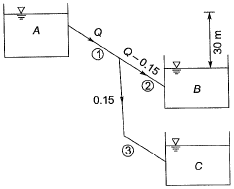

Q15: Two reservoirs are connected through a 930 m long, 0.3 m diameter pipe, which has a gate valve. The pipe entrance is sharp (loss coefficient = 0.5) and the valve is half-open (loss coefficient = 5.5). The head difference between the two reservoirs is 20 m. Assume the friction factor for the pipe as 0.03 and g = 10 m/s2. The discharge in the pipe accounting for all minor and major losses i s _____ m3/s. [2015 : 2 Marks, Set-I]
Ans:

Given:
f = 0.03, L = 930 m, D = 0.3 m , g = 10m/s2
Apply energy equation between A and B,
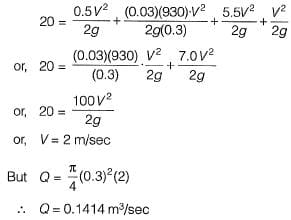
Q16: For steady incompressible flow through a closed- conduit of uniform cross-section, the direction of flow will always be [2015 : 1 Mark, Set-I]
(a) from higher to lower elevation
(b) from higher to lower pressure
(c) from higher to lower velocity
(d) from higher to lower piezometric head
Ans: (d)
In closed uniform conduit, velocity head remains constant, thus flow will be from higher to lower Piezometric head.

Q17: A straight 100 m long raw water gravity main is to carry water from an intake structure to the jack well of a water treatment plant. The required flow through this water main is 0.21 m3/s. Allowable velocity through the main is 0.75 m/s. Assume f = 0.01, g = 9.81 m/s2. The minimum gradient (in cm/100 m length) to be given to this gravity main so that the required amount of water flows without any difficulty is __________. [2014 : 2 Marks, Set-I]
Ans:

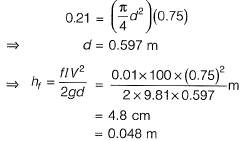

Q18: An incompressible fluid is flowing at a steady rate in a horizontal pipe. From a section, the pipe divides into two horizontal parallel pipes of diameters d1 and d2 (where d1 = 4d2) that run for a distance of L each and then again join back to a pipe of the original size. For both the parallel pipes, assume the head loss due to friction only and the Darcy-Weisbach friction factor to be the same. The velocity ratio between the bigger and the smaller branched pipes is ____. [2014 : 2 Marks, Set-I]
Ans:
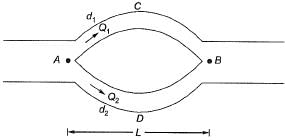
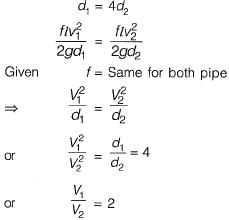
Note: In this problem, Hagen-Poiseuille equation can't be applied because in the problem laminar flow is not mentioned.
Q19: A 2 km pipe of 0.2 m diameter connects two reservoirs. The difference between the water levels in the reservoir is 8 m. The Darcy Weisbach friction factor of the pipe is 0.04. Accounting for frictional entry and exit losses. The velocity in the pipe in (m/sec) is [2013 : 2 Marks]
(a) 0.63
(b) 0.35
(c) 2.52
(d) 1.25
Ans: (a)
Frictional loss,
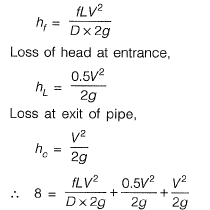
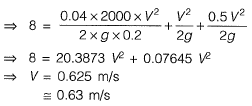
Q20: The circular water pipes shown in the sketch are flowing full. The velocity of flow (in m/s) in the branch pipe “R” is [2012 : 1 Mark]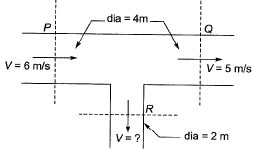 (a) 3
(a) 3
(b) 4
(c) 5
(d) 6
Ans: (b)
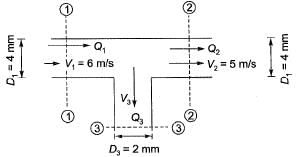
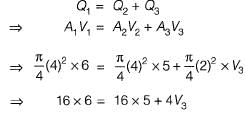
⇒ 16 = 4 V3
⇒ V3 = 4 m/s
Q21: A single pipe of length 1500 m and diameter 60 cm connects two reservoirs having a difference of 20 m in their water levels. The pipe is to be replaced by two pipes of the same length and equal diameter 'd to convey 25% more discharge under the same head loss. If the friction factor is assumed to be the same for all the pipes, the value of ‘d ’ is approximately equal to which of the following options? [2011 : 2 Marks]
(a) 37.5 cm
(b) 40.0 cm
(c) 45.0 cm
(d) 50.0 cm
Ans: (d)
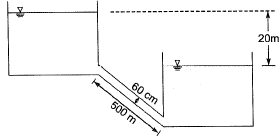
For single pipe,
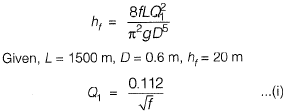
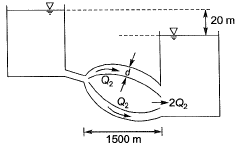
In case of double pipe discharge is increased by 25% than that of previous case hence,

From eq. (i) and (ii), we get,
d = 49.7 cm = 50 cm
|
54 videos|141 docs|115 tests
|
FAQs on Past Year Questions: Flow Through Pipes - Fluid Mechanics for Civil Engineering - Civil Engineering (CE)
| 1. What are the main factors affecting flow through pipes in civil engineering? |  |
| 2. How do you calculate the flow rate in a pipe? |  |
| 3. What is the significance of the Reynolds number in pipe flow? |  |
| 4. What is head loss in pipe flow, and how can it be calculated? |  |
| 5. What are the common methods for determining the friction factor in pipe flow? |  |
















